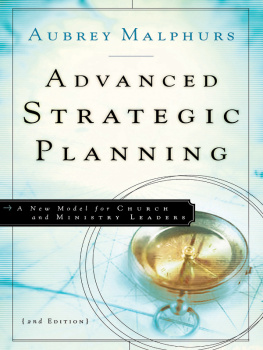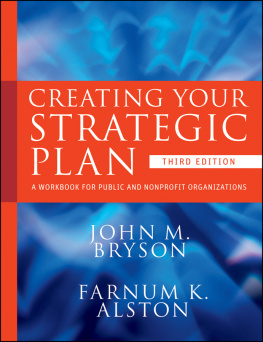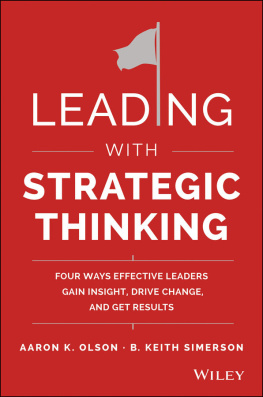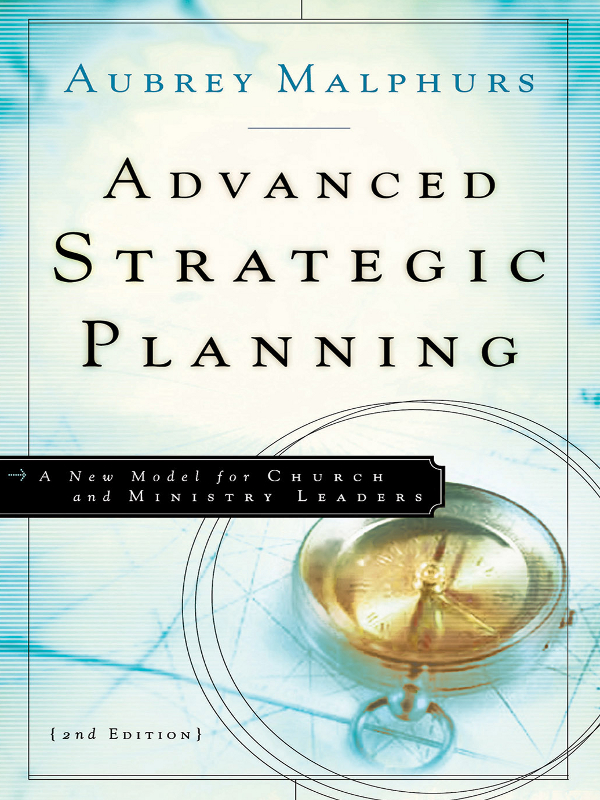
A DVANCED
S TRATEGIC
P LANNING
Also by Aubrey Malphurs
Being Leaders
Biblical Manhood and Womanhood
Building Leaders (coauthor)
Church Next (coauthor)
A Contemporary Handbook for Weddings, Funerals, and Other Occasions
(coauthor)
Developing a Dynamic Mission for Your Ministry
Developing a Vision for Ministry in the 21st Century
Doing Church
The Dynamics of Pastoral Leadership
Leading Leaders
Maximizing Your Effectiveness
Ministry Nuts and Bolts
Planting Growing Churches for the 21st Century
Pouring New Wine into Old Wineskins
Strategy 2000
Values-Driven Leadership
Vision America
Aubrey Malphurs is available for training and consulting on strategic planning and various topics related to leadership. You may contact him through
The Malphurs Group
7916 Briar Brook Ct.
Dallas, TX 75218
214-327-1752
e-mail: amalphurs@dts.edu
website: www.malphursgroup.com
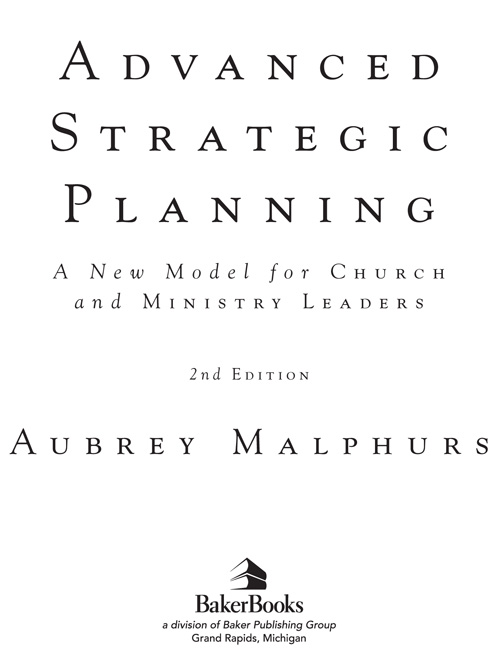
1999, 2005 by Aubrey Malphurs
Published by Baker Books
a division of Baker Publishing Group
P.O. Box 6287, Grand Rapids, MI 49516-6287
www.bakerbooks.com
Ebook edition created 2011
All rights reserved. No part of this publication may be reproduced, stored in a retrieval system, or transmitted in any form or by any meansfor example, electronic, photocopy, recordingwithout the prior written permission of the publisher. The only exception is brief quotations in printed reviews.
ISBN 978-1-4412-0014-3
Library of Congress Cataloging-in-Publication Data is on file at the Library of Congress, Washington, D.C.
Unless otherwise indicated, Scripture quotations are taken from the Holy Bible, New International Version. NIV. Copyright 1973, 1978, 1984 by Biblica, Inc. Used by permission of Zondervan. All rights reserved worldwide. www.zondervan.com
Scripture marked NASB is taken from the New American Standard Bible, Copyright 1960, 1962, 1963, 1968, 1971, 1972, 1973, 1975, 1977, 1995 by The Lockman Foundation. Used by permission. www.lockman.org
Scripture marked NLT is taken from the Holy Bible, New Living Translation, copyright 1996. Used by permission of Tyndale House Publishers, Inc., Wheaton, Illinois 60189. All rights reserved.
C ONTENTS
I spotted the creature sitting off in the distance almost by itself. With long arms that looked like a tangle of dark blue steel tentacles, it reminded me of a large octopus that had crawled out of the ocean nearby. It was nothing of the sort. It was one of several rides operated by a small, traveling carnival that happened to pass through our town close to where my family and I lived. I was alone with my daughter, Jennifer, who at the time was around the impressionable age of four or five. I decided to live a little and have a good time that would make a lasting impression on my little girl. She would discover that Dad wasnt afraid to try something new.
We boarded the monster, and soon it was spinning around at breakneck speed while the tentacles frantically lashed up and down. It was frightening. I began to worry that one of the tentaclesthe one that held uscould possibly tear loose with all the contortions it was going through. We would not survive if it did. I silently prayed and made a vow to God as I held Jennifer tightly against my chest. It went something like this: God, if youget us off this ride alive and in one piece, I promise never to get on another ridefor the rest of my life! God answered my prayer, the octopus let go, and I have kept that vow.
More than at any other time in history, North America, along with much of the world, is exploding with changefast, frightening change. I refer to it as megachange. It has affected every institutionbusiness, government, the schools, and the churchand it is occurring at a number of levels: national, corporate, and individual. The result is a revolution taking place all around us that is likely to be as profound as any in the past. Some wrongly advise us just to be patient, that in time it will all pass. The reality is, however, that there is no end in sight. We have climbed on board the octopus only to discover that it will not let go.
What is the explanation for this megachange? What is happening? Peter Drucker sums it up best:
Every few hundred years throughout Western history, a sharp transformation has occurred. In a matter of decades, society altogether rearranges itselfits world view, its basic values, its social and political structures, its arts, its key institutions. Fifty years later a new world exists. And the people born into that world cannot even imagine the world in which grandparents lived and into which their own parents were born.[]
Druckers point is that we are living at one of those rare points in time when an old worldview (modernism) and many of its trappings are dying and another (postmodernism) has been born. The consequence is a massive shift in our culture, science, society, and institutions. This change is enormously greater than the world has ever experienced, and we are caught in the middle of it. We are living at a frightening point of absolute, chaotic discontinuity, watching the old die off and the new rush in to fill the vacuum.
Where is the church in all this? How is it doing?
The Problem
The answer is, not well. In an earlier book, I noted that in 1988 between 80 and 85 percent of churches in North America had either plateaued or were in decline (dying).[]
Based on my research and consulting ministry with churches, I am convinced that the typical church does not understand the full implications of megachange. Even when a church has some understanding of the implications, it doesnt know how to respond in effective ministry to those becoming immersed in the postmodern paradigm. I believe that the majority of seminaries that prepare people for ministry sit in the same boat with the churches. They are still preparing future pastors for ministry to a modernnot a postmodernworld. Most training equips pastors for one hour on Sunday morning but ignores the other forty-plus hours of the week that demand such things as leadership gifts and abilities, people skills, and strategic thinking and doing. My research, pastoral experience, and church consulting indicate that pastoring a church is a leadership-intensive enterprise. It is imperative that a pastor be able not only to preach to a congregation but to lead and relate well to that congregation.[]
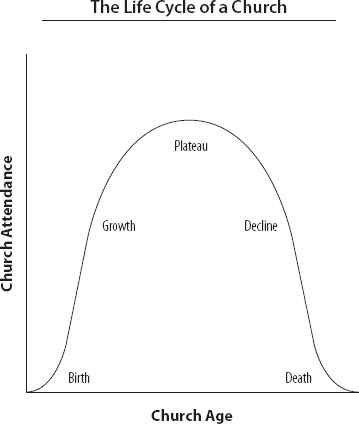
The Explanation
The information above indicates that the North American church is not on a plateau but in decline. It is facing a major growth challenge. It is over the life-cycle hump and moving downward. Before venturing to offer a solution to the problem, I want to look at an explanation for the problem. I believe that an understanding of why the problem exists is a major step toward solving the problem.
Experts have put forth numerous explanations for why the North American church is struggling. Many lay blame. Based on the information above, you could blame the church for not doing a better job of evangelism and edification. If 65 percent of the people in the churches are either plateaued or declining in their spiritual growth, it is no wonder that so many churches are struggling.
Next page
